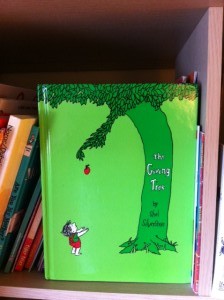I grew up reading Shel Silverstein. I had my own copy of Where The Sidewalk Ends as a child. I often mention some of the poems when talking to my children, such as encouraging them to play hug of war, instead of tug of war; or referencing Jimmy Jet to teach them a lesson on the detriments of too much TV (that only works until they are about 3, maybe 4 years old).
I also read The Giving Tree in many periods of my life. If you haven’t read The Giving Tree yet, I suggest you read it first before continuing to read this blog. You can also watch it narrated by Shel Silverstein here. I remember as a child, and also as a teenager thinking how beautiful the story was, and what true selfless love was about. I idealized the power of selfless service.
Then I heard a professor talk about it in grad school. He used it as an analogy of an unhealthy co-dependent relationship. This was the first time I noticed the boy’s part in the story. I saw that despite the fact that the tree gave him practically all of her, he never gave anything back in return, not even gratitude. I started seeing that giving- even altruistic giving- should be reciprocated, paid forward, or at least recognized.
As an adult, I was torn about how to perceive the book. In one way there is a beauty in the altruism of the tree. However, in another, it seems that her altruism is abused and the boy neglects her. I bought the book to share with my children, as I like stories that we can learn from, I thought this was one with many lessons to learn. Reading it to my daughter recently, I had a revelation that this tree has Superwoman Syndrome! As I came to this realization, I also recognized that this was yet another example of how culture shaped me to do as such; encouraging me to give until depletion, and sustain on just the happiness from serving others.
Here are the reasons why I feel the tree has Superwoman Syndrome:
1) She feels responsible for doing everything for the boy. When the boy is around her, she feels it is up to her to make sure the boy gets what he wants, and will not consider that he can do it on his own, or someone else can do it for him. Even after the boy returns as an adult she feels compelled every time he is around her to be responsible for his wellbeing.
2) She puts the boy’s wants over her needs. The tree is willing to share her fruit, which is understandable. However, when she offers to let the boy take all of her branches, and then her trunk, it is clear that his wishes are more important to her than her own well-being.
3) Her self worth is dependent on how she is able to care for him. When she offers her branches and trunk to the boy, she believes she is “happy”, because she feels most purposeful when she gives to him. When he is gone, she feels purposeless, and is waiting for his return. It’s as if he has power over her self worth.
4) She isn’t truly happy. She is so codependent with the boy that the only time she feels happiness is when she is serving him. This brief feeling of pleasure however is not real happiness. Real happiness comes from within; it isn’t dependent on external factors. It might sway a bit when things get hard, but it doesn’t leave completely.
This story reinforced that when we give so much to others without giving to ourselves first, or without boundaries to protect ourselves, we can lose our sense of self to such an extent that we are no longer the strong, radiant individuals we once were. When we get to that point, we become more dependent on those people we serve to bolster our self worth, purpose, and happiness. Also, when we believe that we can only be happy when we serve other people, it is easy to lose our own identities and become trapped in an endless cycle of self-destructive giving. It is possible to live our lives this way- many women do- but it is neither healthy nor desirable. I wouldn’t want to turn into a theoretical stump just because I believed there was no other way to be happy. Would you?



